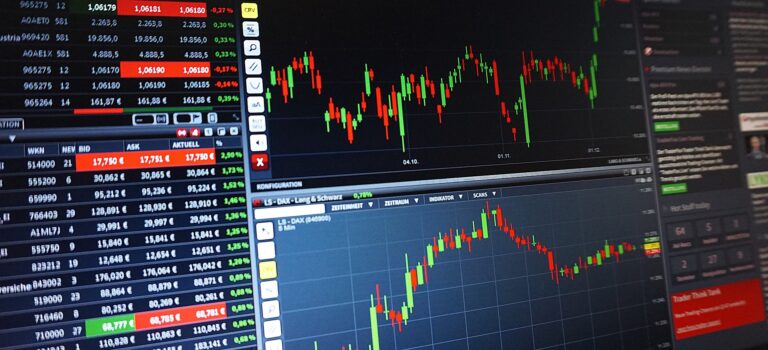The Investor Guide to Fidelity Funds for January 2023 is AVAILABLE NOW! January Data Files Are Posted Below Market Perspective: After a Rough Year, 2023 Should be Positive for Stocks 2023 […]


The Investor Guide to Fidelity Funds for January 2023 is AVAILABLE NOW! January Data Files Are Posted Below Market Perspective: After a Rough Year, 2023 Should be Positive for Stocks 2023 […]

The December Issue of the ETF Investor Guide is AVAILABLE NOW! Links to the December Data Files have been posted below. Market Perspective: Defensive Sectors Should Lead into 2023 Markets gave […]

Stocks were mixed over the past week. While Dow Jones posted a moderate gain of 0.86 percent, the S&P 500 and Nasdaq lost 0.2 percent and 2.2 percent, respectively. Once again, tech stocks took the brunt of the losses.
This was the third straight week in which S&P 500 and Nasdaq ended in the red. The S&P 500’s performance this year is slated to be its worst year since 2008, loosing 18 percent year to date, even when accounting for dividends.
Among the sectors that lost the most in S&P 500, consumer discretionary led the list, which lost 3.1 percent last week and 36.9 percent year-to-date. Closely following it on the downside was the information tech sector losing 2 percent for the week and 28.1 percent year-to-date. Energy gained 4.4 percent for the week and is now up 64.7 percent year-to-date.
The 10-year US Treasury bond yield rose to 3.75 percent on Friday from 3.48 percent seven days ago.
Inflation has cooled since July and should slow further in 2023. The Federal Reserve isn’t declaring victory yet. At its December meeting, the Federal Reserve reiterated the need for higher rates for longer. It stressed the strong labor market, accelerating wage growth and concern about entrenched inflation. Some of the manufacturing surveys underscored this point. The Empire Manufacturing survey covering the New York Fed’s region shifted in an inflationary direction, with the number of firms predicting falling prices next year dropping to zero. The Fed’s own economic forecasts included GDP growth as low as 0.5 percent and unemployment rising to 4.6 percent, along with predicted interest rates rising to around 5.0 percent. The Federal Reserve signaled it will accept some economic slowdown in its battle to wring inflation out of the economy.
The Federal Reserve has been aggressive because economic growth remains strong and labor markets tight. The Atlanta Federal Reserve’s GDPNow model projects 2.8 percent growth for the fourth quarter, about in line with last quarter. Continuing unemployment claims have ticked up, but initial claims have moderated. Wages increased 0.6 percent in November and 5.1 percent versus the prior year. Strong labor markets are lagging indicators, but the Federal Reserve cannot risk nascent wage inflation taking hold. In Federal Reserve Chairman Powell’s December press conference, he mentioned the Fed regional business surveys. While hiring hasn’t been robust, employers are telling the Fed that they can’t find skilled workers. This indicates wage pressures could accelerate if the economy remains strong.
2022 was a rough year for the markets, but performance depended greatly on portfolio positioning. It was not a broad-based bear market that took down everything, even though there were periods where all sectors declined. On the bearish side, four sectors have 25 percent or larger losses heading into the final two weeks of trading: real estate, technology, consumer discretionary and communication services. Except for real estate, these sectors are dominated by stocks that were formerly in the technology sector or are considered tech stocks by investors, such as Amazon and Tesla in consumer discretionary.
Losses are sharply curtailed outside of growth sectors. The next-worst returns came from financials and materials, down about 12 percent each or half of the technology losses. Industrials is down about 5 percent. Consumer staples, healthcare and utilities can all finish the year with gains if the last two weeks are bullish. Energy leads with a return near 60 percent.
As we’ve discussed many times, large-cap tech stocks account for more than 40 percent of the S&P 500 Index. These stocks are responsible for the bulk of the S&P 500’s losses. Additionally, the S&P 500 Index was underweight energy, which has climbed 60 percent.
Fourth-quarter earnings season will be underway soon. With inflation coming down, recession and falling earnings are the main risks on investors’ radar. The S&P 500 Index is expected to see earnings contract by 3 percent. Energy leads with a forecasted growth rate of 64 percent. Analysts see industrials at 38 percent, real estate 10 percent and utilities 3 percent. Consumer staples, technology, healthcare and financials are all expected to see earnings contract less than 10 percent. Weighing on the index are expected dips of 18 percent, 19 percent and 24 percent in the communication services, consumer discretionary and materials sectors, respectively.
There will be a limited amount of data released this week. Home prices are scheduled to be released on Tuesday. Apart from that, Wednesday will see the report on pending home sales. The weekly unemployment data is scheduled to be released on Thursday. After that, however, the most significant report will be released by the government on January 6, which is the government’s monthly employment report.

The Investor Guide to Vanguard Funds for December is AVAILABLE NOW! Links to the December data files are posted below. Market Perspective: Conservative Stocks Protect Investors in 2022 Cooling inflation boosted […]

All three major indexes ended down for the week. Most notably, Nasdaq lost approximately 2.8 percent as the tech stocks didn’t fare well. The S&P 500 declined 2.2 percent for the week, while the Dow Jones Industrial Average lost 1.7 percent.
Among the S&P 500 sectors, it was the consumer discretionary sector that lost the most at 3.6 percent. Perhaps this is not surprising as the year-to-date, it lost 34.8 percent. Information technology lost 2.7 percent for the week and is now down 26.6 percent year-to-date.
The energy sector gained 1.8 percent. No other sector apart from energy in S&P 500 ended the week in the green.
The Federal Reserve increased interest rates for the seventh time. This time around, the increase was half a percentage point, versus 0.75 percent we have become accustomed to. The market was spooked because the Fed officials hinted that the benchmark rate might be even higher next year. The market seemed to haven’t anticipated further hikes in the next year, which spooked it.
A disappointing US retail sales report weighed on the markets on Thursday. The report further strengthens the thought that the Fed might have future rate increases and the economy slides toward a recession. The report showed a decline of 0.6 percent in November, the largest in eleven months, and further raising concerns the thought that the economy might be sliding further into recession.
The problem doesn’t seem to be curtailed in the United States alone.
The central banks around the world in countries like Switzerland, the United Kingdom, European Union also increased the interest rates. The statement by the bank of England that the economy seems to be in a recession further weighed down on stocks globally.
The inflation for the month of November came in at 7.1 percent and remains stubbornly high. If you exclude food and energy costs, the core inflation was only 0.2 percent as compared to the previous month. This marks the slowest inflation increase since August 2021.
With the final two weeks of 2022 nearing, the focus will now shift to the earnings. According to Wall Street analysts, the S&P 500 is slated to record an average growth rate of approximately 5 percent. Even if these forecasts come true, it will be a big slowdown from the 2021 growth rate of 47.9 percent. Truth be told, the 2021 growth rate was high because of the base effect due to Covid 19 crisis. However, even when you consider the average growth rate of the last ten years, it has been around 8.5 percent.
One of the most essential reports next week will be the personal consumption expenditures price, set to be released on Friday. Any negative surprise in this number will surely give rise to more interest rates in the future. The last time this report was released, inflation rose by 5 percent in October, excluding food and energy prices. The number, however, was lower than 5.2 percent in the month before that.
According to the historical data, the next twelve months after the Fed interest rate cycle peak are positive for equity and bonds. That is why equity markets are expected to fare better once the Fed stops hiking rates. If that happens, we might see a broad market rally at the beginning of next year.
As for the numbers next week, quite a few important reports are being released. To start with, on Monday, there is the housing market index report by the National Association of Home Builders. The US bureau of economic analysis will also release the third quarter GDP estimate on Thursday. Additionally, weekly employment claims will be released on the same day.
Key Reports to Look for This Week
Monday:
Housing Market Index by the National Association of Home Builders
Tuesday:
Housing Starts, US Census Bureau
Wednesday:
Existing Home Sales
Consumer Confidence Index
National Association of Realtors
Thursday:
US Bureau of Economic Analysis,
Third-quarter GDP (Estimate),
US Department of LaborWeekly Unemployment Claims,
Friday:
Personal Consumption Expenditures Price Index
Durable goods, US Census Bureau
New Homes Sales, US Census Bureau
The University of Michigan Index of Consumer Sentiment